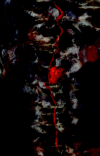Pseudoaneurysm of the anterior spinal artery in a patient with Moyamoya: an unusual cause of subarachnoid hemorrhage
- PMID: 16908584
- PMCID: PMC7977512
Pseudoaneurysm of the anterior spinal artery in a patient with Moyamoya: an unusual cause of subarachnoid hemorrhage
Abstract
Subarachnoid hemorrhage (SAH) is a recognized presentation of Moyamoya disease in adults. Because there are extensive collateral networks and potential complications that develop, a thorough investigation of the intracranial and extracranial circulation is necessary to exclude a treatable cause when these patients present with SAH. We present a case of SAH due to a ruptured pseudoaneurysm of the anterior spinal artery arising from the supreme intercostal artery, which was the sole source of blood supply to the intracranial circulation.
Figures







References
-
- Handa J, Handa H. Progressive cerebral arterial occlusive disease: analysis of 27 cases. Neuroradiology 1973;5:223–30 - PubMed
-
- Takahashi M. Magnification angiography in Moyamoya disease: new observations on collateral vessels. Radiology 1980;136:379–86 - PubMed
-
- Yamada I, Himeno Y, Suzuki S, et al. Posterior circulation in Moyamoya: angiographic study. Radiology 1995;197:239–46 - PubMed
-
- Lee J, Lee J, Kim S, et al. Distal anterior choroidal artery aneurysm in a patient with Moyamoya disease: case report. Neurosurgery 2001;48:222–25 - PubMed
Publication types
MeSH terms
LinkOut - more resources
Full Text Sources
